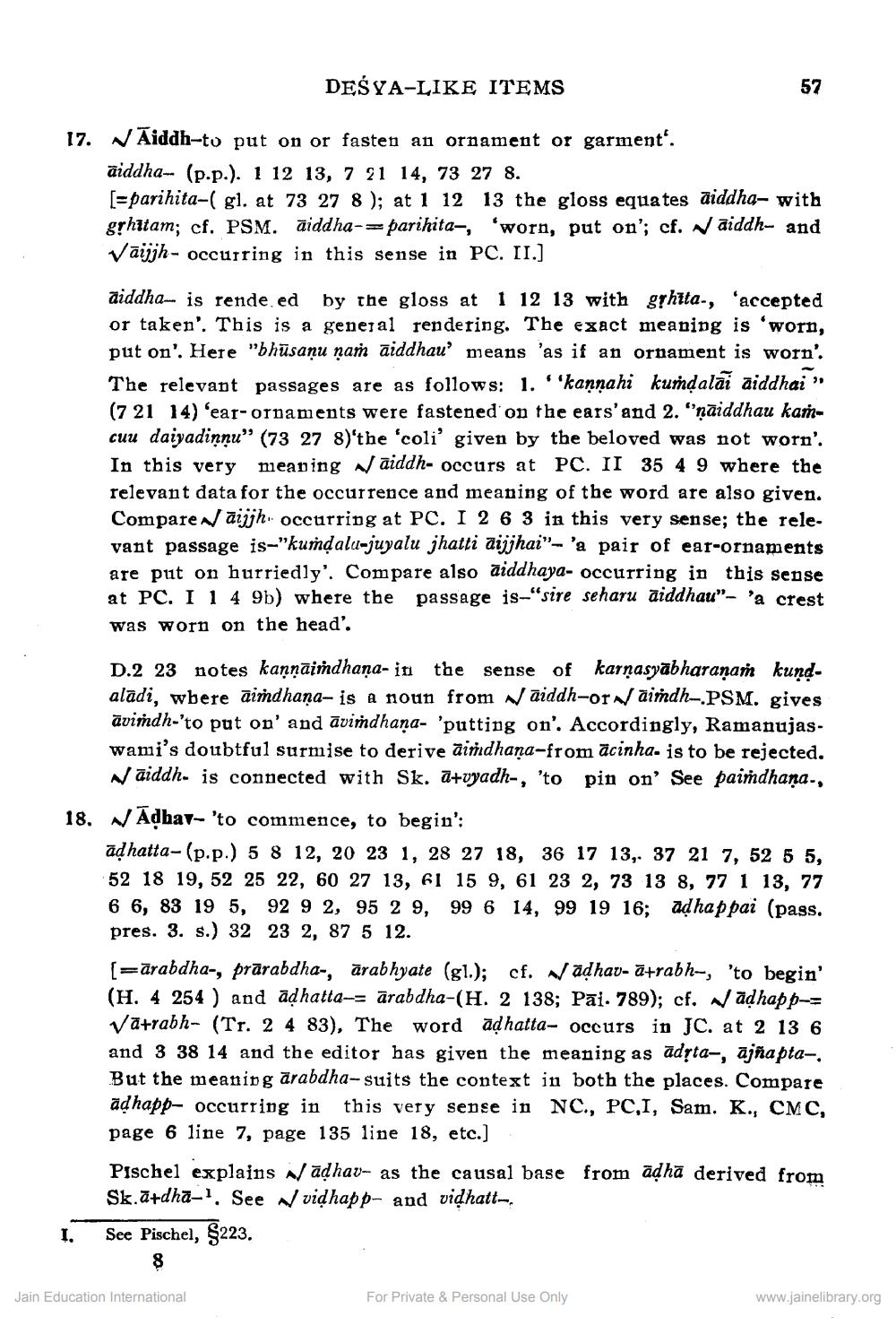________________
DEŚYA-LIKE ITEMS
17. Aiddh-to put on or faster an ornament or garment'.
äiddha- (p.p.). 1 12 13, 7 21 14, 73 27 8. [= parihita-( gl. at 73 27 8 ); at 1 12 13 the gloss equates aiddha- with gļhitam; cf. PSM. āiddha-= parihita-, 'worn, put on'; cf. Näiddh- and Vaijjh- occurring in this sense in PC. II.)
aiddha- is rende ed by the gloss at 1 12 13 with gļhita., 'accepted or taken'. This is a general rendering. The exact meaning is 'worn, put on'. Here "bhūsaņu nam āiddhau' means 'as if an ornament is worn'. The relevant passages are as follows: 1. ''kannahi kundalai aiddhai" (721 14) 'ear-ornaments were fastened on the ears'and 2."ņāiddhau kamcuu daiyadinnu" (73 27 8)'the 'coli' given by the beloved was not worn'. In this very nieaning aiddh- occurs at PC. II 35 4 9 where the relevant data for the occurrence and meaning of the word are also given. Compare aiijh. occurring at PC. I 2 6 3 in this very sense; the relevant passage is-"kumdalu-juyalu jhatti aijjhai"- 'a pair of ear-ornaments are put on hurriedly'. Compare also äiddhaya- occurring in this sense at PC. I 1 4 9b) where the passage is-"sire seharu aiddhau"- 'a crest was worn on the head'.
D.2 23 notes kannāimdhaņa- in the sense of karnasyabharaṇaḥ kundaladi, wbere aimdhana- is a noun from » aiddh-or / äidh-.PSM. gives āviņdh-'to put on' and āvimdhana- 'putting on'. Accordingly, Ramanujaswami's doubtful surmise to derive dimdhaņa-from acinha. is to be rejected. Näiddh. is connected with Sk. a+vyadh-, 'to pin on' See paimdhana.,
18. » Adbar- 'to commence, to begin':
adhatta- (p.p.) 5 8 12, 20 23 1, 28 27 18, 36 17 13, 37 21 7, 52 5 5, 52 18 19, 52 25 22, 60 27 13, 61 15 9, 61 23 2, 73 13 8, 77 1 13, 77 6 6, 83 19 5, 92 92, 95 2 9, 99 6 14, 99 19 16; adhappai (pass. pres. 3. s.) 32 23 2, 87 5 12.
[=ārabdha-, prārabdha-, ārabhyate (gl.); cf. nadhav- ātrabh-, 'to begin' (H. 4 254 ) and adhatta-= ārabdha-(H. 2 138; Pāi. 789); cf. ad happVa+rabh- (Tr. 2 4 83), The word adhatta- occurs in JC. at 2 13 6 and 3 38 14 and the editor has given the meaning as adyta-, ajña ptaBut the meaning arabdha-suits the context in both the places. Compare adhapp- occurring in this very sense in NC., PC,I, Sam. K., CMC, page 6 line 7, page 135 line 18, etc.) Pischel explains adhav- as the causal base from adhā derived from Sk.a+dha-1. See » vid happ- and vidhattSee Pischel, $223.
1.
Jain Education International
For Private & Personal Use Only
www.jainelibrary.org




